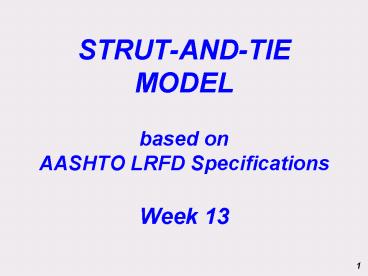STRUT-AND-TIE MODEL based on AASHTO LRFD Specifications Week 13 - PowerPoint PPT Presentation
1 / 27
Title:
STRUT-AND-TIE MODEL based on AASHTO LRFD Specifications Week 13
Description:
... Strength of Struts Limiting Compressive Stress in Strut LRFD 5.6.3.3.3 where: Development of Ties (ACI 318) Strength of Tie LRFD 5.6.3.4.1 Pn = Ast fy + Aps ... – PowerPoint PPT presentation
Number of Views:1234
Avg rating:3.0/5.0
Title: STRUT-AND-TIE MODEL based on AASHTO LRFD Specifications Week 13
1
STRUT-AND-TIE MODELbased onAASHTO LRFD
SpecificationsWeek 13
2
Outline
- Background
- AASHTO LRFD Provisions
- Design Example
3
Background
- STM is a Truss Analogy
- Truss Analogy Used in Standard and LRFD
Specifications - Vn Vc Vs Vs Asfy/sd(cot?)
- AASHTO Standard
- Vs ? 45º Truss
- AASHTO LRFD
- Vs ? Variable Angle Truss
4
LRFD 5.2 - Definitions
- Strut-and-Tie Model - A model used principally in
regions of concentrated forces and geometric
discontinuities to determine concrete proportions
and reinforcement quantities and patterns based
on assumed compression struts in the concrete,
tensile ties in the reinforcement, and the
geometry of nodes at their points of intersection
5
(No Transcript)
6
(No Transcript)
7
(No Transcript)
8
Strut-and-Tie Model (STM)
- Valuable tool for the analysis and design of
concrete members, especially for regions where
the plane sections assumption of beam theory does
not apply
9
STM for D-Regions
Flanged Section
10
STM for D-Regions
Dapped Beam with Opening
11
Past Practice
- D-Regions Designed Based On
- Experience
- Empirical Rules
- Rules of Thumb
12
Strut-and-Tie Model
13
Basic Concepts
- Visualize a truss-like system to transfer load to
the supports where - Compressive forces are resisted by concrete
struts - Tensile forces are resisted by steel ties
- Struts and ties meet at nodes
- For best serviceability, the model should follow
the elastic flow of forces
14
Basic Concepts
- Reinforcement Becomes Active After Concrete
Cracks - Redistribution of Internal Stresses Occurs After
Concrete Cracks - After Cracking, Concrete Structures Behave the
Way they Are Reinforced - For Best Serviceability, the Reinforcement Must
Follow the Flow of Elastic Tensile Stresses
15
Examples of Strut-and-Tie Models
16
Assumptions
- Ties yield before struts crush (for ductility)
- Reinforcement adequately anchored
- Forces in struts and ties are uniaxial
- Tension in concrete is neglected
- External forces applied at nodes
- Prestressing is a load
- Equilibrium must be maintained
17
STM Design Procedure
- 1. Draw Idealized Truss Model and Solve for
Member Forces - 2. Check Size of Bearings
- 3. Choose Tension Tie Reinforcement
- 4. Check capacity of struts
- 5. Check anchorage of tension tie
- 6. Provide crack control reinforcement
18
Examples of Good and Poor STM
19
Factors Affecting Size of Strut
- Width of the strut is affected by
- Location and distribution of reinforcement (tie)
and its anchorage - Size and location of bearing
20
Strength Limit State for STM
- Pr ? Pn (5.6.3.2-1)
- where
- Pr Factored resistance
- Pn Nominal resistance of strut or tie
- ? Resistance factor for tension or compression
(5.5.4.2)
21
Strength of Struts
- LRFD 5.6.3.3
- Unreinforced strut
- Pn fcu Acs (5.6.3.3.1-1)
- Reinforced strut
- Pn fcu Acs fy Ass (5.6.3.3.4-1)
- where
- ? 0.70 for compression in strut-and-tie models
(LRFD 5.5.4.2.1) - Acs effective cross-sectional area of strut
(LRFD 5.6.3.3.2) - Ass area of reinforcement in the strut
22
Limiting Compressive Stress in Strut
- LRFD 5.6.3.3.3
- where
23
Development of Ties (ACI 318)
24
Strength of Tie
- LRFD 5.6.3.4.1
- Pn Ast fy Aps ( fpe fy )
- where
- Ast Total area of longitudinal mild steel
reinforcement on the tie - Aps Area of prestressing steel
- fy Yield strength of mild steel longitudinal
reinforcement - fpe Stress in prestressing steel due to
prestress after losses
25
Limiting Stresses for STM Elements
- LRFD 5.6.3.3 - 5.6.3.5
Element Limiting Stress 1 - CCC Node 2 - CCT
Node 3 - CTT or TTT Node 4 - Strut 5 - Tie
26
Crack Control Reinforcement
- LRFD 5.6.3.6
- Provide orthogonal grid of reinforcement near
each face of D-Region - Maximum Bar Spacing 12 in.
- Ratio As / Ag ? 0.003 in each of the orthogonal
directions - Crack control reinforcement, located within tie,
considered as part of tie
27
DESIGN EXAMPLES
- See PCI BDM































